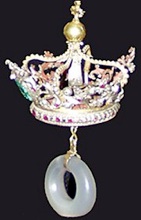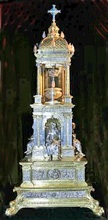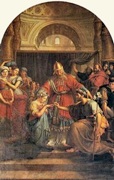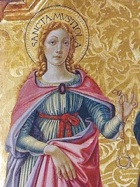


This quartz ring (the Santo Anello) is said to have served as the wedding ring of the Virgin. According to an 11th century account, a Jewish dealer in precious stones in Rome gave it to a jeweller from Chiusi called Ainerio in the late 10th century. He doubted its authenticity until his newly deceased young son was temporarily restored to life in order to vouch for it. It was then transferred to the Basilica di Santa Mustiola, outside the walls of Chiusi. In 1251, it was moved for greater security to the Duomo of Chiusi, which was administered by the canons of Santa Mustiola. It was moved again, this time to San Francesco, Chiusi in 1420.
Theft of the Relic
An inscription in the cloister of the Palazzo dei Canonici records that a certain Fra Wintherius (Winterio) brought the ring to Perugia in 1473 and arranged through an intermediary to donate it to the city. He was imprisoned for two years while charges against him were investigated, but was then released and settled in Perugia. (He served as rector of San Giovanni del Mercato (now the Cappella di San Giovanni Battista of the Collegio di Cambio) until his death in 1506. He was buried in the Cappella del Santo Anello in the Duomo (see below), where his tomb survived until 1770).
What the inscription does not say is that Fra Wintherius had stolen the relic during his stay in the Franciscan convent at Chiusi. The Sienese, who controlled Chiusi, appealed to the Pope Sixtus IV, but he arbitrated in favour of the Perugians, and the ring was duly secured in a trunk with seven keys inside a metal grating in Palazzo dei Priori. (Sixtus IV compensated the Chiusians for the loss of the Santo Anello by approving the fortuitous re-discovery of the relics of St Mustiola in the catacomb near the basilica dedicated to her and by formally recognising her cult.
Tortuous negotiations continued until 1486, when Pope Innocent VIII ruled in favour of Perugia.
Cult in Perugia
In 1487, the Observant Franciscan Bernardino da Feltre preached in Perugia on the importance of the cult of St Joseph (whose feast had been introduced into the calendar in 1479) and the Santo Anello. He formed the Compagnia di San Giuseppe, which was mandated to support these cults, and was inscribed as its first member. Fra. Bernardino also obtained permission for what was the Cappella di San Bernardino da Siena to be re-dedicated to St Joseph. His feast was celebrated in Perugia for the first time on July 31st, 1487. Bishop Dionisio Vagnucci translated the Santo Anello from Palazzo dei Priori to the new chapel in the Duomo (usually called the Cappella del Santo Anello) a year later.


The relic is housed in a reliquary (1498-1511) by Federico and Cesarino Roscetto, in which it hangs from a gilded silver crown (1716) that was donated by Ippolito della Corgna. The reliquary is usually behind curtains above the present altarpiece in this chapel. However, it is exhibited on the altar each July 31st, the anniversary of its translation to this location. It is traditionally venerated by pilgrims en route for Santa Maria degli Angeli, Assisi to celebrate the Festa di Perdono there on August 2nd.
At the time of my visit in January 2013, the relic (or possibly a replica of it) was exhibited in the Cappella di Santo Anello in what seems to be a replica of the reliquary (illustrated above, to the right).
Santo Anello in Art



Perugino: (1499-1503) Carlo Labruzzi: (1814) Jean-Baptiste Wicar: (1825)
Perugino’s altarpiece (1499-1503) of the Marriage of the Virgin decorated the altar of the Cappella del Santo Anello until 1797, when it was confiscated by the French. (It is now in the Musée des Beaux Arts, Caen). It was replaced by two altarpieces on the same subject in quick succession:
-
✴The first replacement by Carlo Labruzzi was installed in 1814 but proved to be unpopular. (It is now in the Museo Capitolare).
-
✴Its replacement in 1825 by Jean-Baptiste Wicar was also controversial, but that survives in situ.

Scientific Investigation
Miska Michele Tosti (in the book referenced below) reported on the recent scientific investigation of the ring. This revealed it to be made of a form of quartz known as chalcedony. The cavity at the widest part of it probably held a seal. His observations confirmed those of an investigation carried out in 1949-50, which suggested that the relic is actually a man’s signet ring from the 1st century AD.
Read more:
R. Caracciolo (Ed.), “Il Santo Anello: Leggenda, Storia, Arte, Devozione”, (2005), Perugia
Return to Saints of Perugia

